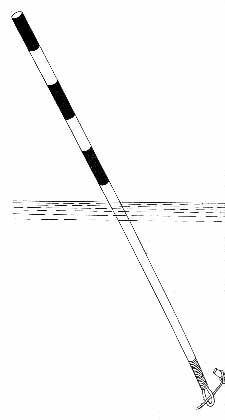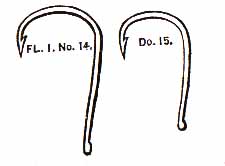TACKLE REQUIRED FOR
ANGLING AT
POWAI LAKE
By : Lambert Dias
Introduction
Fishing tackle the world over varies widely. Each is designed for the specific type of angling intended, the type of fish available, their
feeding habits, the characteristics of the water body being fished in and several other considerations. Hence it is
imperative to identify the tackle most suitable for angling at Powai if you are to be confident of success and to enjoy the sport.
|
This article will basically cover the requirements of equipment required for catching the Major Carps such as
Catla, Rohu, Calbose, Hybrid, Silver Carp and the Mrigal.
The most popular form of fishing for Major Carp in India is known as Bottom Fishing (also known as Coarse Fishing) i.e.
at the floor of the lake, and is ideally attempted in water of depth from 6 to 12 feet. Under these conditions the fish will nibble at the hook
bait and in the process brush against your fishing line. These moments of contact are transmitted to the float “cocked” at the surface and are
perceived as vibrations or dips of the float. When one is sure of a fish at the bottom as indicated by the nature of movement of the float, then
one executes a "Strike" so as to sink the hook into the intended
quarry. This strike is executed by giving a sharp upward movement of the rod in an attempt to transfer all the force to the hooks at the bottom.
It would not be out of place here to convey that it is for this reason that the last section of the rod should be of reasonable thickness and
strength so that the strike is firm. Keeping in mind this system of angling, I make my observations below on the type of tackle.
|
In this article
Mr. Lambert Dias, the author gives us the benefit of information based on personal and practical experience coupled with the opinions of
angling companions gathered over a period of 27 years of angling at Powai. In addition to fishing at
Powai, the author has also fished at most of the major lakes around Mumbai and in
Maharashtra. Surf casting for Rawas, Bekti (Khajura), Karli and Gobra (Rock Perch) at the sea shore
in the appropriate seasonal months has always been a relaxing sport. |
Yesteryears
Looking back as a historic review of tackle used at Powai in the early stages of
existence of our Association, the only rods available were hand made from Bengal
Ringal - Bamboo or imported Split Cane. The reels were of simple Drum
Type. This tackle was very elementary and it is really admirable that anglers of those days could so
skillfully
play and land fish as heavy as 85 lbs and more. The play could last for hours , as the equipment did not lend itself to
the modern techniques that our tackle of today is capable of.
Now
Coming to the ideal tackle for use at Powai today, one would naturally need a Rod, Reel, 15 lbs Line (or line of lesser breaking strength
if one is to enjoy the sport thoroughly), a Float, Hooks suitably snelled with a Swivel, Lead weight etc.
|
The Author
Mr. Lambert Dias in grey outfit with a 36lb. Catla he caught at Powai in
October 1997. Along with him is Mr. Austin Lobo a fellow angler.
The rod used is the Yellow Abu seen in the picture.
The reel was a
Cardinal 77X with 15 lb line. |
 |
Line and Strength
We explain here the meaning of breaking strength line.
The breaking strength of 15 lbs. is the maximum strength of Line allowed. Using heavier Lines makes it possible to wrench in an extra
large fish in a matter of minutes, but, then that is not sport. In fact using finer lines of 10 lbs. breaking strength or less really gives one
the thrill of the sport. If a little higher than 15 lb weight is suspended from the fishing line ,theoretically it should snap, stronger line will not. This 15 lbs.
strength is specified to allow the type of game fish at Powai Lake a sporting chance, which is what Angling is all about.
This author has personally watched a fellow angler - Mr. Penda Khan land an 84 lbs Catla
on a 10 lb. Line.
Rods:
Nowadays Fibre glass rods are mostly used. The hollow type are preferred as they are
lighter. Rods are usually of two pieces
joined together. Telescopic rods are also used as they are easier to collapse for
traveling or
storage. However, based on personal experience these telescopic rods do tend to break more easily, when striking a fish or accidentally hitting
the roof of the boat. There are many manufacturers of fishing equipment but they are mainly in foreign countries and among these
are: Abu, Garcia-Mitchell,
Shakespeare, Dam, Diawa and many more. A two piece rod can be up to 9 or 10 feet in length.
A telescopic rod can be 12 to 14 feet long. For convenience, the reel seat should be of the sliding type and the reel should be seated about a foot from the base of the rod. If the
reel is fixed then it should be about a foot from the rod base. Do not use rods with reel seats away from the base as you are always
fishing from a boat and it becomes clumsy to position and handle such rods,
besides the effective length gets reduced with high mounted reel seats. You are usually sitting in a chair and positioning your rod between your knees, hence this
recommendation about
reel seats.
Reels: Most Rod manufacturers also make Reels. Reels are meant to balance and match with the respective Rod used and these
details are explained in catalogues with model no. to guide you. A Line capacity of 150 metres of 15 lb. Line is adequate. The present
day angler should know that modern equipment we use nowadays is more sophisticated, thus making angling easier. Open Spool reels
are preferred although some anglers use drum type reels. Reels have Gears and Drag controls that
can be set to the needs of the angler or the situation. Lighter Lines offer more enjoyable angling and gives the fish a sporting chance.
Floats:
The Float to use is made of the shaft of peacock feather, however plenty of alternatives are offered by manufacturers. A small
stopper i.e. a rubber band is tied on the Line so as to keep the Float correctly
cocked while the Hooks and Bait lie at the bottom of the fishing area. In Powai practically all use peacock feather marked as inch long digits. |

|
Hooks:
The majority of anglers at Powai use hooks made by MUSTAD of Oslo, Norway. Other manufacturers also offer suitable
hooks. The much preferred hook from MUSTAD is Model No:92554. A strength of three extra strong is suitable : The size is 5/0 or 6/0.
|

  |
Another recently offered Hook by MUSTAD is Model No:92554 N.P. BLN. These Hooks are chemically sharpened. They are much
sharper than other Hooks and never need sharpening.
Snelling of Hooks for Angling:
Two hooks are tied together approximately 3 - 4 inches apart. A Swivel and Lead weight is necessary. Various methods of snelling are employed with a choice of Silk or Nylon. (see typical illustrations). Treble
hooks are forbidden at Powai. |

 |
Hook Bait:
Bait used is usually bread paste waterproofed with salt free butter and flavoured with aromatic attractants like rotten
Bananas , over ripe Jackfruit, or Aniseed oil, smelly Cheese etc and attached to the
hook in the shape of a cashew nut as shown in the diagram. |
 |
Ground Bait:
This is to draw the fish to the Angling spot. This is made of ghee
residue, cake crumbs, khullee; (mustard, groundnut or coconut oil-cake) and aromatic herbal mixes available from Calcutta. All these are
mixed with red clay/mud and made into tennis size balls and, thrown at the fishing spot where the baited Hooks lie. (A
separate article
on Ground Bait appears in another part of this website). |
 |
Other Accessories:
Remember to have with you a Landing-net to Land the fish you catch and a Holding or Keep-net to keep your fish
alive in the water until you leave for home.
Looking forward to seeing you angling at Powai Lake.








